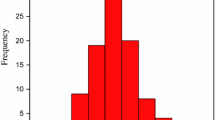Summary
This study was conducted to determine the relationships among various agronomic traits in inbreds, hybrids and between inbreds and their progeny of maize in short season areas. Phenotypic correlations of each measured trait between as well as among hybrids and inbreds were not the same. The highest correlation coefficient (r=0.78) was obtained between days to anthesis and yield. The high yielding inbreds did not necessarily give rise to high yielding progeny. Given that days to anthesis plays an important role in two major traits (yield and moisture) for hybrids, an emphasis on optimum anthesis dates during inbred development could be a useful criterion for the prediction of hybrid performance in short season areas.
Similar content being viewed by others
References
Adalana, B. & G.M. Milbourn, 1972. The growth of maize II. Dry matter partition in three maize hybrids. J. Agric. Sci. 78: 73–78.
Allard, R.W., 1960. Principles of Plant Breeding, p. 270. John Wiley & Sons, Inc.
Arnold, C.Y., 1969. Inherited characteristics of sweet corn as they relate to time required for development. J. Amer. Soc. Hortic. Sci. 94: 112–115.
Bonaparte, E.E.N.A. & R.I. Brawn, 1976. Effects of different environments on leaf number and duration to flowering in corn. Can. J. Plant Sci. 56: 699–704.
Boniciarelli, F. & M. Monotti, 1975. Growth analysis of hybrid corn of different earliness. Maydica 20: 39–55.
Chase, S.S., 1963. Relation of yield and number of days from planting to flowering in early maturity maize hybrids of equivalent grain moisture at harvest. Crop Sci 4: 111–112.
Chase, S.S. & D.K. Nanda, 1967. Number of leaves and maturity classification in Zea mays. Crop Sci. 7: 431–432.
Cross, H.Z., 1986. Breeding for improved relative growth rates in early maize. p. 61. In. Agronomy Abstracts. ASA Madison, WI.
Dwyer, L.M. & D.W. Stewart, 1986. Leaf area development in field grown maize. Agron. J. 78: 334–343.
El-Lakany, M.A. & W.A. Russell, 1971. Relations of maize characters with yield in test crosses of inbreds at different plant densities. Crop Sci. 11: 699–701.
Gardiner, M.L., 1986. Selection and evaluation of maize for short-season environments of northern New York. Ph.D. Diss., Cornell University, Ithaca, NY.
Kuleshov, N.N., 1932. Behavior of American corn strains and hybrids in USSR. J. Amer. Soc. Agron. 24: 416–417.
Kuleshov, N.N., 1933. World's diversity of phenotypes of maize. J. Amer. Soc. Agron 25: 688–700.
Muldoon, J.F., T.B. Daynard, B.van Duinen & M. Tollenaar, 1984. Comparisons among rates of appearance of leaf tips, collars, and leaf area in maize (Zea mays L.). Maydica 29: 109–120.
Sinclair, T.R., 1984. Leaf area development in field grown soybeans. Agron. J. 76: 141–146.
Watson, D.J., 1956. Leaf growth in relation to crop yield. pp. 178–191. In: F.L. Milthorpe (Ed). The Growth of Leaves. Butterworths, London.
Author information
Authors and Affiliations
Rights and permissions
About this article
Cite this article
Samanci, B. Phenotypic correlations between maize inbreds and their single cross hybrids in short season areas. Euphytica 89, 291–296 (1996). https://doi.org/10.1007/BF00022284
Received:
Accepted:
Issue Date:
DOI: https://doi.org/10.1007/BF00022284




